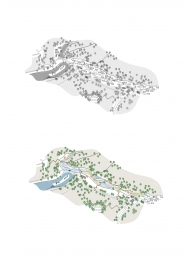Wetlands - Chevetogne
Restoration of semi-natural wetlands in the heart of the Chevetogne park. Modification of the roads and creation of new walking and discovery routes.
The project is located at the heart of the Chevetogne estate, which covers an area of approximately 600 hectares of countryside and woodland.
In its center, a 200-hectare leisure park welcomes 450,000 visitors every year to its gardens, museums, restaurants, accommodation and recreational, relaxation and exploration spaces.
The work concerns a 4-hectare portion of the countryside, at the confluence of the Molinia and Mivau streams. These have carved out two small valleys with wooded hills and feed the park’s ponds.
During the 1970s, a portion was channelled, the meadows were drained and roads were planned in order to set up a caravan site.
50 years later, the project involves restoring the countryside to a semi-natural state made up of wetlands.
The landscape project has to address several challenges: the environment, mobility, functionality and identity!
The priority is ecological and hydrological. The project must ensure a strong renaturation of the site.
The river sections will be retraced through the center of wet meadows, with meanders and marshes.
These areas encourage biodiversity and the water cycle and regulate flow variations.
The project must incorporate the crossing of a main road serving all the areas of the Domain.
Rather than building a bridge, the design allowed the level to be lowered as close as possible to the water, like a ford, thanks to the installation of a hydraulic structure.
1.5kms of footpaths have been created to explore, link and extend the site from one end to the other and beyond
Picnic tables and play area bring the site enliven for the many walkers.
The project creates an openfield landscape, putting the infrastructure in the background and offering a kind of ‘in nature’ immersion.
The raw material is the landscape: water, stone, earth and vegetal. Completely redesigned, the winding valleys appear as a natural composition.
This naturalness makes it an asset but requires appropriate management. Between mowing, grazing, removing sediment, topping willows, etc. in dry or rainy years, beaver visits, the management plan is developed year after year with the Domain’s gardeners.
The wooden paths with their straight lines are becoming more established, anchored in the wetlands and on the hillsides using screw piles to limit the impact on the ground.
Numerous networks cross the site (sewers, power lines, water pipes) and have been renovated and relocated.
The main structures are the steel piano weir and the concrete submerged bridge.
These original structures allow vehicles to pass through and maintain water levels during periods of low water or flooding.








